
|
The Sentry™
Card# MTU-017

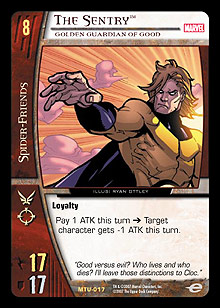
While his stats aren’t much bigger than those of the average 7-drop, Sentry’s “Pay ATK” power can drastically hinder an opponent’s attacking options in the late game.
Click here for more
|
|
|

|
|
|

 |
 |
|
|
| |
|
I see this a lot going into local game stores on certain game nights:
Timmy: "I’ll draw . . . and . . . "
Jimmy: "You’ll pass."
Timmy: " . . . I’m thinking."
Jimmy: "Just pass. You’re going to pass. Just do it."
Timmy: *looking irritated* "I might not! I might—"
Jimmy: " . . . pass? Yeah, you might. In fact, you will, so pass. You have like, one card in your hand, just pass."
Timmy: "I hate you."
Jimmy: "I know."
Jimmy: "You gonna pass yet?"
Timmy: *glowering* "Yeah, I pass."
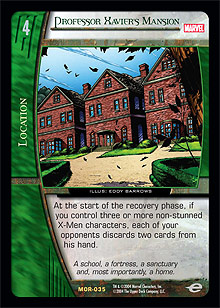 We’ve all seen it, in a lot of games. "Control", it’s called. Decks that, regardless of game system, cut off your opponent’s options not necessarily through clever play and strategic positioning, but through the use of cards that deprive the opponent of things to do, denying them draws, countering their moves, and stripping their hand of cards. In the past in some games it’s gotten completely ridiculous, and I think I’ve seen more people leave games entirely out of frustration due to being stomped on by control decks than for any other single reason. We’ve all seen it, in a lot of games. "Control", it’s called. Decks that, regardless of game system, cut off your opponent’s options not necessarily through clever play and strategic positioning, but through the use of cards that deprive the opponent of things to do, denying them draws, countering their moves, and stripping their hand of cards. In the past in some games it’s gotten completely ridiculous, and I think I’ve seen more people leave games entirely out of frustration due to being stomped on by control decks than for any other single reason.
Needless to say, the Vs. System isn’t overrun by control. Black swirling capes and all, the dev guys might be evil, but they’re not that evil. Crushing dreams may be a staple of their day to day work, but things like eating babies and letting control decks run rampant aren’t.
That said, there are some pretty attractive hand destruction options in the current Vs. releases that are only now starting to get the attention they should probably have. Today I want to look at them, compare them a bit, and see which have different forms of potential. The shared mechanic isn’t uniformly templated, but if it makes an opponent discard one or more cards, it’s in today’s group for scrutiny.
The worth of this mechanic is obvious, as in any TCG the bulk of your options are usually greatly, if not entirely, dependant on the contents of your hand. Fewer cards in hand means fewer options, and the number of options you have is generally proportionate to your chance at winning. In algebraic terms, options = good.
 In Vs., hand destruction is particularly hurtful. The majority of the decks on the tourney scene don’t run any recursion. A Doom control deck might be running one Reconstruction Program, and Sentinel decks may run it as well, but the only deck really running a reliable source of recursion that doesn’t require a lot of effort to use is the aggro Brotherhood strain coming into popularity now. Avalon Space Station grants the deck a level of recursive control infinitely better than any other deck can manage. To anything else, hand destruction is potentially crippling, simply because hitting a turn’s drop is so important in the Vs. System. The boost keyword might make hand destruction a bit less deadly, but there’s no guarantee. Currently, if you watch your 6-drop hit the KO’d pile from your hand on turn 5, and you don’t happen to have another one immediately available, you’re not going to be particularly thrilled with your newfound play position. In Vs., hand destruction is particularly hurtful. The majority of the decks on the tourney scene don’t run any recursion. A Doom control deck might be running one Reconstruction Program, and Sentinel decks may run it as well, but the only deck really running a reliable source of recursion that doesn’t require a lot of effort to use is the aggro Brotherhood strain coming into popularity now. Avalon Space Station grants the deck a level of recursive control infinitely better than any other deck can manage. To anything else, hand destruction is potentially crippling, simply because hitting a turn’s drop is so important in the Vs. System. The boost keyword might make hand destruction a bit less deadly, but there’s no guarantee. Currently, if you watch your 6-drop hit the KO’d pile from your hand on turn 5, and you don’t happen to have another one immediately available, you’re not going to be particularly thrilled with your newfound play position.
For that reason any card that sends a card of your opponent’s choice from his or her hand to the KO’d pile is good. Any card that does it at random is better, and any card that lets you choose the card discarded is flat-out awesome. With that in mind, let’s look at some of the hand destruction options Vs. currently has on offer, starting with characters.
The cheapest of the bunch belongs to the X-Men (which is kind of a running theme to hand destruction, actually). Psylocke allows a hand-destruction player to open up with the hand-hurting on turn 3. On her own, her ATK is average for the 3-drop spot on the curve but low in the big picture, so an ATK bonus can help her out. In order to maintain card advantage, it’s naturally best to use a set plot twist to give the needed bonus, but a Dual Sidearms or even a Twin Firearms can be a great investment, allowing Psylocke to threaten the opponent’s hand from a defended position in the support row while giving her a nice ATK bonus to get that all-important breakthrough damage (Twin Firearms being especially nice, since it has the potential for a higher ATK contribution). One of Psylocke’s major strengths is that she isn’t team-proprietary: she doesn’t have a loyalty condition (requiring another X-Men character to be in play for her to be recruited), and her effect doesn’t require there to be any additional X-Men characters on the field. She’s one of the most convenient hand destruction cards in the game and is both a staple of most hand destruction decks, as well as an attractive splash for any deck looking for a bit of hand control.
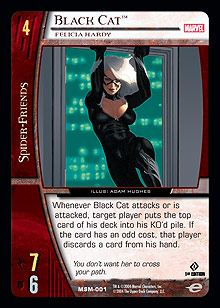 Next up, one of the choice offerings from the Spider-Man Vs. Doc Ock starter set. Black Cat, Felicia Hardy represents the character’s ability to manipulate matters of luck and chance. As a 4-drop character with 7 ATK and 6 defense, Felicia is pretty average stats-wise, but her effect is a gem. Though her effect is a bit of a toss-up in the hand destruction department, and will be less effective against decks that are skewed more towards cards with even costs (Brotherhood and Doom might have a slight advantage), it’s important to remember two things. First up, the effect works both when she attacks (regardless of outcome) and when she defends, meaning you can potentially use it twice or even more than twice in a single turn (once for being attacked, and once for attacking if she survives). Second, though characters are sometimes skewed towards even-numbered recruit costs in certain decks, most popular plot twists have odd-numbered costs; The New Brotherhood, Flying Kick, Foiled, One-Two Punch, Overload, Children of the Atom, Fastball Special, Cosmic Radiation, Signal Flare, Faces of Doom, and more are all hits for Felicia’s effect. As with Psylocke, the opponent chooses the card discarded, but it’s still very nice. Also like Psylocke, Black Cat is not team-proprietary. Next up, one of the choice offerings from the Spider-Man Vs. Doc Ock starter set. Black Cat, Felicia Hardy represents the character’s ability to manipulate matters of luck and chance. As a 4-drop character with 7 ATK and 6 defense, Felicia is pretty average stats-wise, but her effect is a gem. Though her effect is a bit of a toss-up in the hand destruction department, and will be less effective against decks that are skewed more towards cards with even costs (Brotherhood and Doom might have a slight advantage), it’s important to remember two things. First up, the effect works both when she attacks (regardless of outcome) and when she defends, meaning you can potentially use it twice or even more than twice in a single turn (once for being attacked, and once for attacking if she survives). Second, though characters are sometimes skewed towards even-numbered recruit costs in certain decks, most popular plot twists have odd-numbered costs; The New Brotherhood, Flying Kick, Foiled, One-Two Punch, Overload, Children of the Atom, Fastball Special, Cosmic Radiation, Signal Flare, Faces of Doom, and more are all hits for Felicia’s effect. As with Psylocke, the opponent chooses the card discarded, but it’s still very nice. Also like Psylocke, Black Cat is not team-proprietary.
Also sitting at the 4-drop spot is Robot Enforcer. With 1 less ATK, Robot Enforcer has range to make up for his slight ATK deficiency, and it’s of note that the player forced to discard a card when it attacks does not necessarily have to be the player against whom the attack was made. It’s an army card, so you could potentially have a cluster of them. Unfortunately, the Enforcer requires another Doom card to be in play for it to work, so it’s only potentially useful in a Doom or Doom–X-Men deck (barring getting two into play at the same time). The opponent selects the card discarded, but what really kills the card is its requirement of having another Doom army character in play. Since Black Cat is now in the environment and is almost inarguably superior, Robot Enforcer’s moment in the spotlight is probably over. If you can call waving from the shadows a "moment in the spotlight". Which really, you can’t . . .
Next up, at the 5-drop level is Professor X, Charlex Xavier. With 8 ATK/8 DEF, the good Professor is just a little bit behind his place on the curve. However, for the sacrifice of stats, you get probably the best mass-discard character in the game. He’s only pseudo-costed, so he can be splashed into any deck that needs some hand destruction, and when you do have another X-Men character in play, he can give his first piece of hand advantage on the same turn in which he was recruited (one card from the opponent balancing out the Professor’s recruitment from the hand to the field, the other earning the first card of hand advantage). He has some restrictions: his activated effect can’t be used until the combat phase, and the card discarded is still your opponent’s choice. But if you could activate him at any time, he’d be totally broken and would completely kill resource development, and the fact that the opponent chooses the card to be discarded is only a minor setback. He’s really exceedingly good, and his X-Men team affiliation and range give him synergy in possible hand destruction builds beyond just his effects.
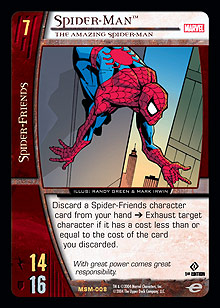 Last up in the character mix is Mystique, Shape-Changing Assassin. As a 6-drop, she’s not going to see play until later in the game, but she makes up for her cost by being the only character in the game thus far to allow her controller to choose the card to be discarded from the opponent’s hand. Amazing Spider-Man? Gone. Berserker Rage? Gone. Scientific Genius? Not so smart when he’s sitting in the KO’d pile . . . She can prevent a lot of important cards from seeing play and break an opponent’s plans in half in the mid-late or late game. Beyond that, her stats are about 0.5 above average for the 6-cost spot on the curve (albeit in line with the median figures), and though she only discards one card you can see all the others and then plan accordingly. Intelligence kills in Vs., especially in the later turns of a game. In Limited, Mystique is even better, providing both that ever-important 6-drop character, with no Loyalty requirement or pseudo-costing whatsoever. If your opponent missed his or her 6-drop and is counting on an in-hand 7-drop, chucking it to the KO’d pile with Mystique probably means game in a Limited format. Very nice. Last up in the character mix is Mystique, Shape-Changing Assassin. As a 6-drop, she’s not going to see play until later in the game, but she makes up for her cost by being the only character in the game thus far to allow her controller to choose the card to be discarded from the opponent’s hand. Amazing Spider-Man? Gone. Berserker Rage? Gone. Scientific Genius? Not so smart when he’s sitting in the KO’d pile . . . She can prevent a lot of important cards from seeing play and break an opponent’s plans in half in the mid-late or late game. Beyond that, her stats are about 0.5 above average for the 6-cost spot on the curve (albeit in line with the median figures), and though she only discards one card you can see all the others and then plan accordingly. Intelligence kills in Vs., especially in the later turns of a game. In Limited, Mystique is even better, providing both that ever-important 6-drop character, with no Loyalty requirement or pseudo-costing whatsoever. If your opponent missed his or her 6-drop and is counting on an in-hand 7-drop, chucking it to the KO’d pile with Mystique probably means game in a Limited format. Very nice.
Up next, the only location to make the list: Professor Xavier’s Mansion. A good number of X-Men are needed to back it up (though it can be playable in a dual-team deck), and it takes some effort to meet its condition, but the Mansion is one of the best hand destruction cards currently available, and a backbone of some of the best hand control decks currently in existence. It’s often difficult by turn 4 to keep three characters from being stunned, but with Children of the Atom and a few cards that dish out exhaustion in a deck, it is very doable. Alternatively, one can always go the "interesting" way and use Marvel Team-Up to unite the X-Men and Sentinels . . . That way hordes of Wild Sentinels can run the Mansion instead of pricey X-Men—it’s apparently enough to fool those outside the Mansion, by gameplay standards.
So far, Vs. offers four plot twists which give hand destruction. The first, and possibly the most usable, is Greater of Two Evils. It’s the only one out of the four that doesn’t require a team affiliation–carrying character to be in play, so it fits into a lot of decks, and it has a really impressive effect. It has a cost of 4, which is a drawback, and your opponent gets to choose whether to stun a character or discard two cards. In some ways, it can almost be seen as a Finishing Move with twice the threshold cost, but no exhaust requirement. If you’re using it, you’re either going to get a KO or up to two cards of card advantage. It’s a personal favourite of mine, despite the fact that it’s a high-cost card and your opponent gets to choose which character is KO’d. The solution to the latter limitation is, naturally, to only stun one character. In the late-game, if your opponent is sitting on a single prime character, Greater of Two Evils can really justify committing your characters to one big team attack. It’s quite good, and in my mind it’s underplayed in most current metagames.
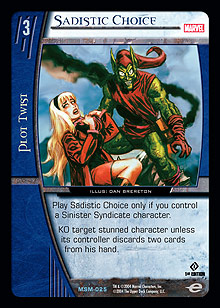 Sadistic Choice is sort of a Lesser of Two Evils. It costs 1 less to play, and you get to target the character who might be stunned. In addition, it can be used whenever you like, as opposed to being restricted to the recovery phase like Greater of Two Evils. Unfortunately, its requirement for a Sinister Syndicate member to be in your control limits it greatly. Not many of the Syndicate members are particularly splashable other than Rhino, so it’s currently more of a Syndicate-only card. Still, in such a deck it can be very, very good, threatening the opponent with a double-pronged aggression befitting of the Sinister Syndicate’s methods. It’s highly playable due to its speed and utility, but unfortunately, it’s limited to a few decks. Sadistic Choice is sort of a Lesser of Two Evils. It costs 1 less to play, and you get to target the character who might be stunned. In addition, it can be used whenever you like, as opposed to being restricted to the recovery phase like Greater of Two Evils. Unfortunately, its requirement for a Sinister Syndicate member to be in your control limits it greatly. Not many of the Syndicate members are particularly splashable other than Rhino, so it’s currently more of a Syndicate-only card. Still, in such a deck it can be very, very good, threatening the opponent with a double-pronged aggression befitting of the Sinister Syndicate’s methods. It’s highly playable due to its speed and utility, but unfortunately, it’s limited to a few decks.
Search and Destroy is yet another team-proprietary plot twist with hand destruction potential. Though its main power rests in clearing the field for a Primary Directive or three, and the card likely shouldn’t be run in anything other than a dedicated Sentinel deck, its discard effect has a special use: messing over Quicksilver. Honestly, most of the success that I’ve seen this card have has been going up against Brotherhood decks, where large quantities of both Quicksilvers are so common that a Search and Destroy often has a good chance of knocking one or even two cards out of the hand. A great card? No. But it has its place in some Constructed-format Sentinel decks.
Last up, the biggest discard effect of the game: Doom Triumphant. With a cost of six, a condition requiring the opponent to have at least three stunned characters in play, and a need to not only have a Dr. Doom in play but also to exhaust him, Doom Triumphant can be considered a Doom-only card and one that’s difficult to play at that. The conditions and costs are high, and the card is likely unplayable in Limited, but the effect does command a certain level of fear.
At the top of the heap for Constructed are Professor X, Black Cat, Psylocke, and Professor Xavier’s Mansion (with Greater of Two Evils getting honorable mention). Combined with Dazzler and Puppet Master for stall and protection, and Rogue, Power Absorption to mimic them and Professor X, they form the core of a tourney-winning X-Men hand destruction deck. For splashability, Black Cat and Psylocke can’t be beat, and Mystique can make a venerable splash if used correctly as well.
In Limited, Mystique is queen. One of the all-important 6-drops, her stats are enough to get her by and dominate most anything smaller than her, and if she hits for breakthrough on turn 6, she can lock the game in favour of her controller. Greater of Two Evils, Psylocke, and Black Cat are also quite good, with Charles taking a bit of a dive since he can’t be splashed and retain his full effects. The Mansion becomes very difficult to play, and the three team-specific plot twists are relegated to the category of "great if you happen to have the team, not great if you don’t."
That’s hand destruction in a nutshell. Thanks for reading, and tune in next time when I take a look at a group of cards that are becoming highly popular: cards that deal out exhaustion to the opponent.
|
| |
| Top of Page |
|
 |
|
|
 |